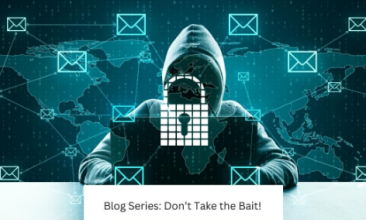Protecting the Pond
In an effort to keep our customers up to speed on the latest trends when it comes to fraud detection and prevention, ThreatMark presents our phishing blog series: Don’t Take the Bait! Follow along as we take you through the holidays, the busiest time for fraudsters, and help you educate your customers on the most common phishing hooks that can easily be avoided.
Welcome back! What we’re talking about this week is a thoroughly proactive spin on fraud prevention. I think we all know, at this point, the standard practices employed to prevent fraud once a threat has been established. Our industry is saturated with protocol for this scenario. But what about fraud prevention so proactive that you stop it before it even starts? Now, we’re not exactly talking Tom Cruise Minority Report tech here, but it’s not too far off. What we’re talking about is a team of market-leading analysts dedicated on your behalf to stopping fraud at the level of intent – before it even reaches the level of threat.
Have you met the Cyber Fraud Fusion Center?
Fraud Fusion at Its Finest
Officially defined as the process of combining two or more distinct entities into a new whole, the term “fusion” is typically reserved for eclectic eateries and orthopedic principles. That is, until now. So, what are we fusing together and how are we serving it up?
Well, I’m glad you asked!
The Cyber Fraud Fusion Center (CFFC) consists of market leading cyber fraud expertise with unparalleled visibility across the ThreatMark portfolio of customers – meaning we not only have the ability to anticipate it, we also have the authority to stop it before it even starts. And we’re talking anticipatory threat prevention for every customer, in every scenario, and across every potential fraudulent network – even the ones they don’t know we know about!
How do we do it? The CFFC has established relationships with application stores, search engine providers, internet domain registrars and hosting providers to get malware and phishing risks shut down before they even start, quickly minimizing the potential impact on you and your customers. This includes:
- Fishing for Phishers: Not only do we catch them, but we also bait em,’ hook em,’ and fry em’ all on your behalf! Our expert analysts are combing the waters consistently in an effort to anticipate any potential phishing intent. And, again, I’d like to point out that we said intent here – not attack – meaning we get them before they even attempt to get your customers. Once we have established intent, we shut the site down to ensure no dirty lines get cast into your professional pond.
- Mining for Malware: At CFFC, we have a strict policy against going viral! We make it our business to know all the ins and outs of any potential viruses threatening your portfolio. You can think of us as a living, breathing antivirus software that works 24/7 on your behalf to combat the human element (arguably the weakest link when it comes to fraud) and prevent the potential of infectious malware attempts. And believe it or not, a lot of it starts with our phishing detection services as many malware attempts are initiated through sophisticated phishing scams.
Did you know?
There is an ever-escalating battle between those who write malware and those who produce the virus protection software. You can never be completely safe from malware with just anti-virus software alone because there is always a lag, however short, between the detection of a new piece of malware and the updating of virus protection software to respond to the impending malicious attack.
- Mitigating for Mobile: Part of our power to stop fraud at its source is the leverage we have from our trusted relationships. Not only can we detect malicious applications, we can also work with the mobile application providers to shut the app down before any fraudulent activity is initiated.
How Well Does It Work?
Well, we don’t want to bait our own hook, but the results are pretty impressive! Every month, the CFFC publishes the most recent numbers regarding fraudulent activity that has been both prevented and combated as a result of our industry experts. Below are some of the notable October stats:
- 694 phishing notifications and takedowns. This includes a complete removal of the site, preventing any potential for future fraudulent activity. We had 143 incidents in October 2021, which is 420% increase (year over year).
- 2 multi-phishing attacks detected and prevented. Multi-phishing refers to more than one phishing attempt initiated simultaneously at multiple institutions.
- 600 applications reclassified as financial malware.
On average, ThreatMark detects 85% of all phishing pages and the rest (15%) is reported to us by our customers. Not to mention:
- 237% more phishing sites taken down (YOY)
- 321% more phishing emails identified (YOY)
- 373% improvement in app detection (YOY)
- 70% better rate than our competitors (ERSTE Group)
In other news, quarterly reports published by APWG claim that the financial industry has witnessed a 30-40% increase in phishing scams this quarter alone. But don’t worry. We’re on it!
We are currently under negotiations with the top hosting providers to integrate with their abuse reporting mechanism, which will add significant momentum to our proactive prevention of all phishing scams.
Get Hooked!
When it comes to fraud detection and prevention, one could easily say it all comes down to phishing! Or, more specifically, your capacity to avoid it. In fact, it could even be argued that phishing is the primary point of contact on most fraudulent attempts – which is why so much begins and ends with it.
ThreatMark understands this and we are at the forefront of the phishing dock, with the Behavioral Intelligence necessary to keep your waters clean and your customers safe. Our Cyber Fraud Fusion Center (CFFC) provides the market leading expertise, tools, and threat prevention necessary to stop scams before they even reach your customers!
Why fight fraud when you can stop it before it even starts?


